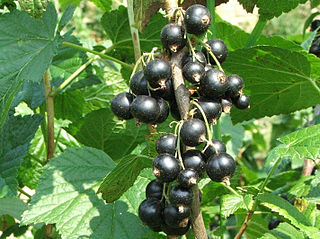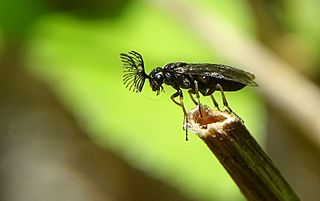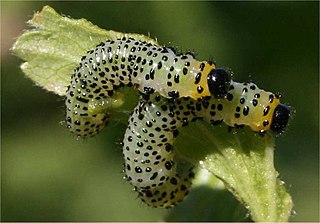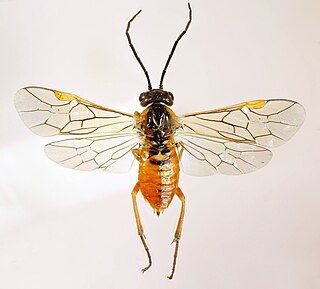
Gooseberry is a common name for many species of Ribes, as well as a large number of plants of similar appearance. The berries of those in the genus Ribes are edible and may be green, orange, red, purple, yellow, white, or black.

The blackcurrant, also known as black currant or cassis, is a deciduous shrub in the family Grossulariaceae grown for its edible berries. It is native to temperate parts of central and northern Europe and northern Asia, where it prefers damp fertile soils. It is widely cultivated both commercially and domestically.

Ribes is a genus of about 200 known species of flowering plants, most of them native to the temperate regions of the Northern Hemisphere. The various species are known as currants or gooseberries, and some are cultivated for their edible fruit or as ornamental plants. Ribes is the only genus in the family Grossulariaceae.

The Tephritidae are one of two fly families referred to as fruit flies, the other family being the Drosophilidae. The family Tephritidae does not include the biological model organisms of the genus Drosophila, which is often called the "common fruit fly". Nearly 5,000 described species of tephritid fruit fly are categorized in almost 500 genera of the Tephritidae. Description, recategorization, and genetic analyses are constantly changing the taxonomy of this family. To distinguish them from the Drosophilidae, the Tephritidae are sometimes called peacock flies, in reference to their elaborate and colorful markings. The name comes from the Greek τεφρος, tephros, meaning "ash grey". They are found in all the biogeographic realms.

The Diprionidae are a small family of conifer-feeding sawflies restricted to the Northern Hemisphere, with some 140 species in 13 genera. Larvae are often gregarious, and sometimes there can be major outbreaks, thus these sawflies can be major forest pests at times. These sawflies have the ability to compromise the health and ecological balance of forests. When the temperatures begin to rise, the sawflies become strengthened pests to these conifers. In doing so, they cause damage to a certain extent.

Cecidophyopsis ribis is an eriophyid mite which is best known for being a plant parasite, a pest of Ribes species, the genus that includes gooseberries and blackcurrants. It is commonly known as the blackcurrant gall mite or big bud mite. It feeds on the plants' buds, forming galls, and transmits a virus which causes blackcurrant reversion disease. The mite is a serious pest of blackcurrant crops in Europe, but rarely on other continents.

Nematus ribesii is a species of sawfly in the family Tenthredinidae. English names include common gooseberry sawfly and imported currantworm. This insect is best known as a pest of gooseberries. The larvae feed on the foliage of the plant, often defoliating it completely.
The English name gooseberry sawfly refers to at least three species of sawfly:

Actinidia deliciosa, the fuzzy kiwifruit, is a fruiting vine native to Southern China. Other species of Actinidia are also found in China and range east to Japan and north into southern areas of Russian Far East. This species grows naturally at altitudes between 600 and 2,000 metres.

The white currant or whitecurrant is a group of cultivars of the red currant, a species of flowering plant in the family Grossulariaceae, native to Europe.

Nematinae is a subfamily of sawflies belonging to the family Tenthredinidae. It contains over 1250 described species in ~40 genera. Members of this subfamily feed on a wide range of plants and employ a wide range of feeding habits, both internally and externally, on their host plants.

Nematus leucotrochus is a species of sawfly in the family Tenthredinidae, known as the pale-spotted gooseberry sawfly. Widespread throughout central and northern Europe, this insect is best known as a pest of gooseberries. The larvae feed on the foliage of the plant, defoliating it. Unlike Nematus ribesii, the common gooseberry sawfly, the species has a single brood. Adults appear in early May and larvae in May and June.

Nematus spiraeae is a species of sawfly in the family Tenthredinidae, known as the aruncus sawfly and sometimes the spiraea sawfly. It is native to central and northern Europe and was first recorded in Britain in 1924. Its larvae feed on the leaves of goat's beard.
Hoplocampa testudinea, the apple sawfly or European apple sawfly, is a species of sawfly in the family Tenthredinidae. It is native to Europe but has been accidentally introduced into North America where it became invasive. The larvae feed inside the developing fruits of the apple tree.

Nematus oligospilus, commonly known as the willow sawfly, is a species of sawfly in the family Tenthredinidae. Native to central and northern Europe and Asia, it was first recorded in South America in the 1980s and New Zealand in 1997, and has also been introduced to Australia, South Africa and Lesotho. Its larvae feed on the leaves of various species of willow.
Nematus ventralis, the willow sawfly, is a species of common sawfly in the family Tenthredinidae.

Nematus myosotidis is a Palearctic species of sawfly.

Nematus lucidus is a Palearctic species of sawfly.























